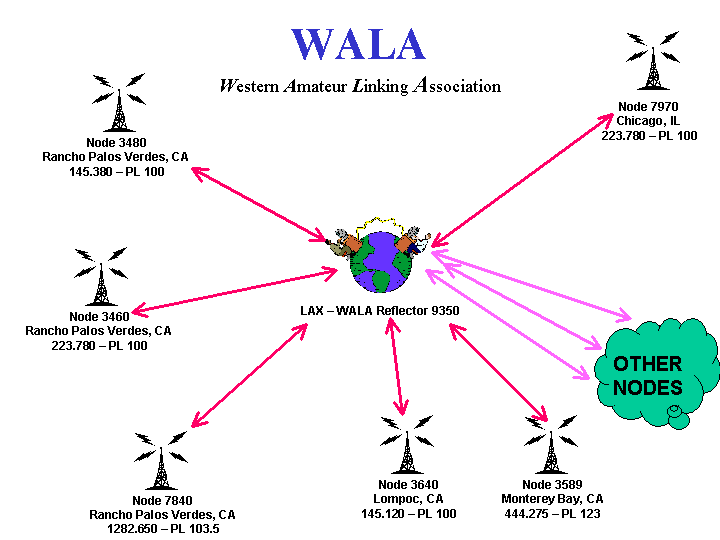

Drop Repeater
A drop repeater is an access or gateway to the WALA system. Typically these repeaters are VHF UHF, although they can occupy any of the amateur bands. You might think of a drop repeater as a "cell" not unlike the technology used in cellular telephone communication. Where each drop repeater covers a particular geographical area. These drop repeaters are scattered throughout the world. Generally speaking the drop repeaters are owned either by other amateur radio clubs or individuals. By sending the on link code (DTMF tones) an amateur can connect the repeater to the system and through additional link codes to distant location.
Pass-through Site
A pass-through, as the name suggests, passes the trunk signal on from one destination to the other. They are used to increase the signal strength between two distant locations. They are configured as two back to back radios. As one radio receives a signal, the other radio transmits the received transmission down the trunk. Faithful audio reproduction between radios is critical in such an arrangement or DTMF tones will be ineffective. A pass-through can not be used as an entry point to the trunk.
Hub Repeater
Throughout the system WALA maintains a number of repeaters. A hub repeater is a collection point for all incoming signals from drop repeater or pass-through sites. Unlike a pass-through repeater, amateurs can directly access the trunk through a hub repeater. Think of a hub repeater as like a wheel of a bicycle. Where the repeater is the centre hub and the spokes are the incoming signals. Any number of drop repeaters can be linked to a hub repeater, providing the path from the source to the hub site meets the required fade margin.
Fade Margin
The fade margin is simply, the amount of signal that is required under any propagation variable to make a reliable point to point contact. These figures are used to determine where pass-through and hub repeaters are placed along the system.
DTMF Tones
The method used to control drop repeaters on the WALA system are DTMF tones. While not the most effective signaling technology to work with, it is the one that is standard to amateur radio equipment. It is essential that the level or deviation of your tone pad be properly adjusted. Poorly adjusted tone pads will result in the inability to turn drop repeaters on or off.
Link Codes
Link codes are the DTMF tones used to turn drop repeaters on and off the system. They consist of three digits the first being the number ? followed by an additional two numbers and a ?. Once a decoder hears the proper sequence of tones it will respond to the command.
Turn Around Time
This corresponds to the time it takes the half duplex system to go from the transmit stage to the receive stage and vice-versa. The further the two drop repeaters are apart the longer the turn around time will be.
Half Duplex
The WALA trunk is configured in a half duplex manner. That means only one station can talk at once while the other(s) listen. Once the transmiting station drops the push-to-talk the system turns around and the other station can reply.
Terrestrial Network
This is a network that is land based, where point to point communication is achieved through a number of hops using only land based technology. Many commercial systems rely on satellite technology to cover greater distances or rugged terrain.
Hop
A hop is what we refer to as the distance between a drop repeater, hub repeater or pass-through and the next location. Hops can cover great or short distances depending on terrain, tower height, and antenna gains.